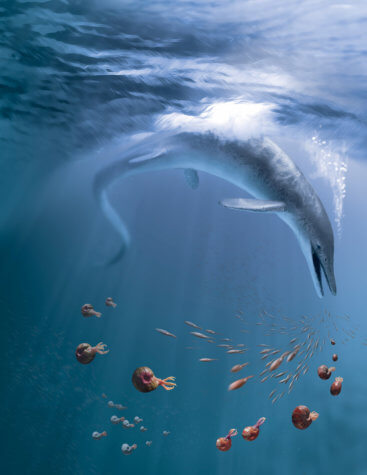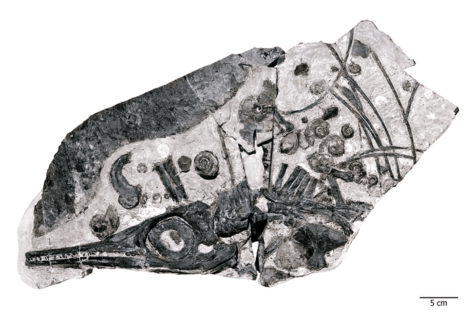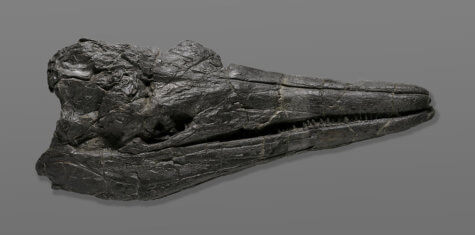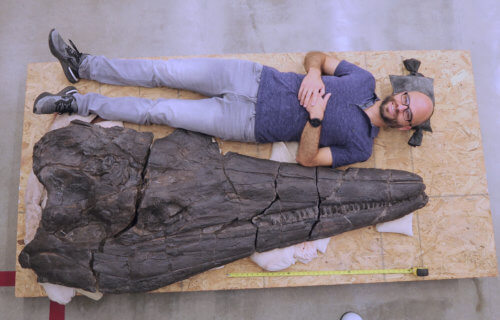LOS ANGELES, Calif. — A giant prehistoric sea monster found in one of the driest places on Earth shows how quickly the species evolved in size, a new study reveals. An international team believes this gigantic creature lived 244 million years ago, when a vast ocean covered the United States.
Based on the size of its skull, the animal was at least 60 feet from nose to tail and weighed more than 40 tons — rivaling today’s biggest whales. The species, Cymbospondylus youngorum, belonged to a group of aquatic reptiles known as ichthyosaurs.
The discovery in Nevada’s Black Rock desert shows how quickly they evolved. Its oldest ancestor emerged only 2.5 million years earlier and was only about three feet long.

“Ichthyosaurs derive from an as yet unknown group of land-living reptiles and were air-breathing themselves,” says lead author Dr. Martin Sander, a paleontologist at the University of Bonn and Research Associate with the Dinosaur Institute at the Natural History Museum of Los Angeles County (NHM), in a media release.
“From the first skeleton discoveries in southern England and Germany over 250 years ago, these ‘fish-saurians’ were among the first large fossil reptiles known to science, long before the dinosaurs, and they have captured the popular imagination ever since.”
Ichthyosaurs grew up fast
Researchers identified the animal from its remarkably preserved skull, which alone measures more than six feet in length. A team unearthed it in a remote area of treeless mountains, rugged canyons, and dry lake beds.

Ichthyosaurs appeared in the oceans after the Permian mass extinction 252 million years ago. Scientists believe they had fish-like bodies similar to tuna but breathed air like dolphins and whales. The apex predators were likely the Great White sharks of their day.
Cymbospondylus was “exceptionally large,” hinting at an early and rapid burst in the evolution of extreme body size in Mesozoic oceans.
“Evolutionary models show very clearly that ichthyosaurs had an initial boom in size, becoming giants early on in their evolutionary history, while whales took much longer to reach the outer limits of huge,” says senior author Dr. Lars Schmitz in a university release.
“We assume that ichthyosaurs were also able to evolve so rapidly because they were the first larger creatures to populate the world’s oceans and were exposed to less competition,” adds Sander.
History’s ‘first big splash’
The findings in the journal Science also suggest marine food webs during the Triassic could support such massive creatures. Eventually, climate change wiped out this species about 90 million years ago, ending their rule of the oceans during the Age of Dinosaurs.

“As researchers, we often talk about similarities between ichthyosaurs and cetaceans, but rarely dive into the details. That’s one way this study stands out, as it allowed us to explore and gain some additional insight into body size evolution within these groups of marine tetrapods,” says NHM’s Associate Curator of Mammalogy, Dr. Jorge Velez-Juarbe.
“Another interesting aspect is that Cymbospondylus youngorum and the rest of the Fossil Hill Fauna are a testament to the resilience of life in the oceans after the worst mass extinction in Earth’s history. You can say this is the first big splash for tetrapods in the oceans.”
Dr. Lene Delsett and Dr. Nicholas Pyenson, of the Smithsonian National Museum of Naturral History, notes that this discovery provides lessons for today’s environment.
“Ichthyosaur history tells us ocean giants are not guaranteed features of marine ecosystems,” the researchers, who did not take part in the study, tell SWNS in a statement. “It is a valuable lesson for all of us in the Anthropocene, especially if we want to sustain the presence of the surviving ocean giants among us that contribute to our own well-being.”
South West News Service Mark Waghorn contributed to this report.
